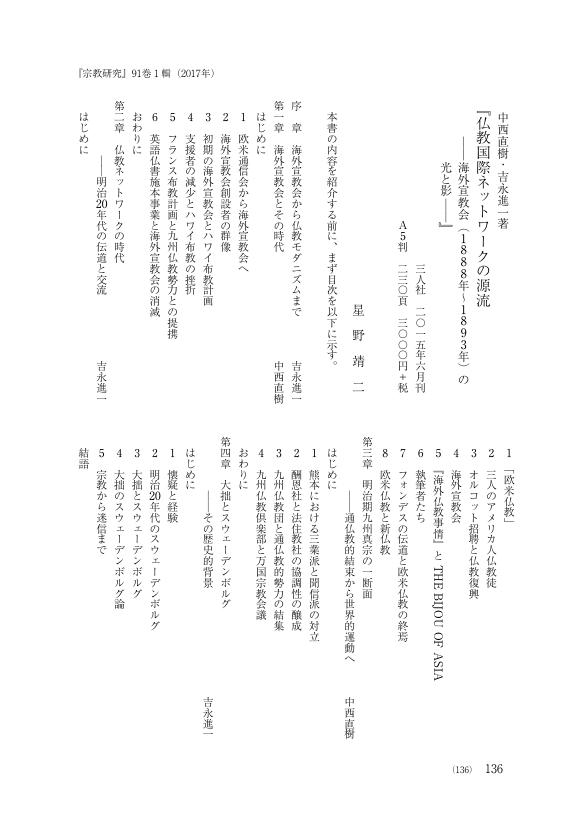3 0 0 0 OA 近代日本における知識人宗教運動の言説空間-『新佛教』の思想史・文化史的研究
- 著者
- 吉永 進一 安藤 礼二 岩田 真美 大澤 広嗣 大谷 栄一 岡田 正彦 高橋 原 星野 靖二 守屋 友江 碧海 寿広 江島 尚俊
- 出版者
- 舞鶴工業高等専門学校
- 雑誌
- 基盤研究(B)
- 巻号頁・発行日
- 2008
本研究では、仏教清徒同志会(新仏教徒同志会)とその機関誌『新佛教』に関して、基礎的な伝記資料を収集しつつ、多方面からモノグラフ研究を進めた。それにより、新仏教運動につながる進歩的仏教者の系譜を明らかにし、出版物、ラジオ、演説に依存する宗教運動という性格を分析した。新仏教とその周辺の仏教者によって、仏教の国際化がどう担われていたか、欧米のみならず他のアジア諸国との関係についても論証した。
3 0 0 0 OA 宗教概念ならびに宗教研究の普遍性と地域性の相関・相克に関する総合的研究
- 著者
- 池澤 優 近藤 光博 藤原 聖子 島薗 進 市川 裕 矢野 秀武 川瀬 貴也 高橋 原 塩尻 和子 大久保 教宏 鈴木 健郎 鶴岡 賀雄 久保田 浩 林 淳 伊達 聖伸 奥山 倫明 江川 純一 星野 靖二 住家 正芳 井上 まどか 冨澤 かな
- 出版者
- 東京大学
- 雑誌
- 基盤研究(B)
- 巻号頁・発行日
- 2010
本研究は、欧米において成立した近代的宗教概念とそれに基づく宗教研究が、世界各地、特に非欧米社会においてそのまま受容されたのか、それとも各地域独自の宗教伝統に基づく宗教概念と宗教研究が存在しているのかをサーヴェイし、従来宗教学の名で呼ばれてきた普遍的視座とは異なる形態の知が可能であるかどうかを考察した。対象国・地域は日本、中国、韓国、インド、東南アジア、中東イスラーム圏、イスラエル、北米、中南米、ヨーロッパである。
- 著者
- 星野 靖二
- 出版者
- 日本宗教学会
- 雑誌
- 宗教研究 (ISSN:03873293)
- 巻号頁・発行日
- vol.91, no.1, pp.136-142, 2017-06-30 (Released:2017-09-15)
1 0 0 0 IR 『宗教及び文藝』に見る明治末期のキリスト教の一側面
- 著者
- 星野 靖二
- 出版者
- 東京大学文学部宗教学研究室
- 雑誌
- 東京大学宗教学年報 (ISSN:02896400)
- 巻号頁・発行日
- no.20, pp.55-71, 2002
- 著者
- 星野 靖二
- 出版者
- 日本宗教学会
- 雑誌
- 宗教研究 (ISSN:03873293)
- 巻号頁・発行日
- vol.88, no.2, pp.481-487, 2014-09-30 (Released:2017-07-14)
- 著者
- 星野 靖二
- 出版者
- 日本思想史・思想論研究会
- 雑誌
- 思想史研究 (ISSN:13471465)
- 巻号頁・発行日
- no.3, pp.140-157, 2003-03
1 0 0 0 OA 『宗教及び文藝』に見る明治末期のキリスト教の一側面
- 著者
- 星野 靖二
- 出版者
- 東京大学文学部宗教学研究室
- 雑誌
- 東京大学宗教学年報 (ISSN:2896400)
- 巻号頁・発行日
- vol.20, pp.55-71, 2003-03-31
This essay examines the character of a Christian magazine called Shukyo oyobi bungei (Religion and Literature), founded in 1911 by Uemura Masahisa, a leading Japanese Christian of the Meiji era. From 1890, Uemura devoted himself to organizing the Nihon Kirisuto Kyokai (the Japan Christian Church), which achieved the status of a self-supported church in 1908. In the process of its foundation, the Church strategically concentrated on the urban middle class as a target of its mission work. It therefore attracted considerable numbers of urban youth, students in particular. An investigation of the contents of Shukyo oyobi bungei reveals that almost all of its articles discuss theological, philosophical, or religious matters. Furthermore, its news columns and book reviews are dedicated to intellectual issues of that time. This publication was thus more a scholarly journal than a popular magazine. Scholars writing for Shukyo oyobi bungei insisted on the existence of phenomena leading into and/or emerging from Christian faith. Kashiwai En contributed an article about affirming faith through research on religion, and Tanaka Tatsu wrote about being led to belief in Christianity through comparing it to other religious traditions. The influence of Uemura's ideas can be detected in these discussions of the relationship between academia and religion. These assertions, however, should not be ascribed solely to Uemura's intentions. The influence of the magazine's readership, including students, and of social movements such as Shuyo Undo (the Personal Cultivation Movement) was also considerable. The position of youth in the Church was an issue of particular importance. While movements such as Shuyo Undo tended to stress the mystical aspects of religion, Shukyo oyobi bungei insisted that research on religion based in rational investigation was crucial in acquiring faith. The rational standpoint of this magazine should be viewed in relation to the fact that serious theological studies emerged at this time within Japanese Christianity. As the study of philosophy of religion also arose in this period, it can be postulated that there was a growing need for an intellectual explanation of religion. It is therefore concluded that Shukyo oyobi bungei was essentially a scholarly journal, and was a publication that, while influenced by Uemura's ideas on religion and the academy, served as a response to the intellectual and spiritual needs of the youth of this era.

